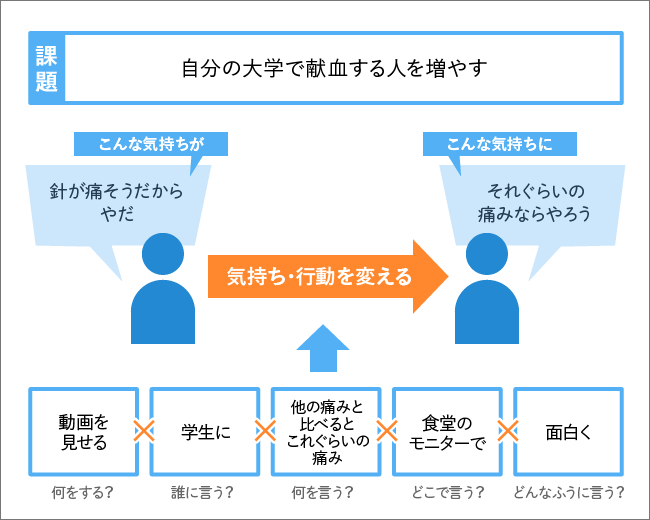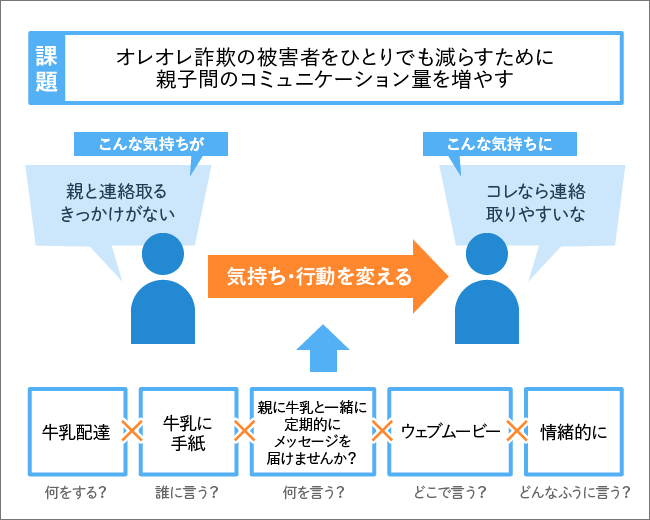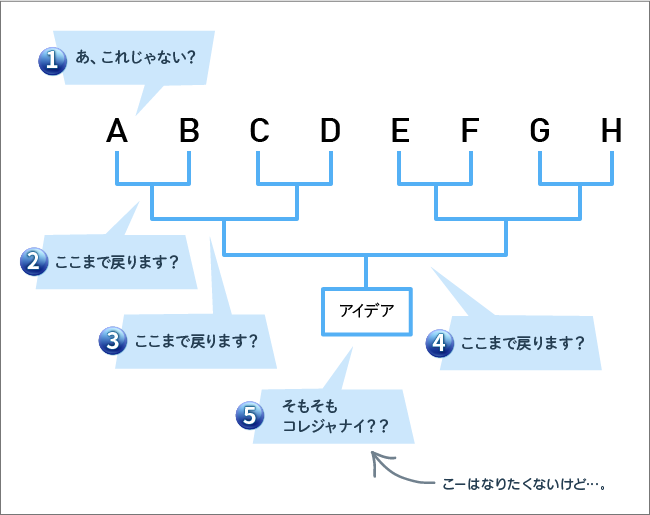Methods for generating and nurturing ideas, even for those unfamiliar with brainstorming
This series features Dentsu Inc. employees who served as instructors for the 2018 "Dentsu Inc. Internship," introducing their approaches to thinking, planning techniques, and work methodologies. This time, Creative Director Kei Suzuki discusses methods for generating ideas and nurturing them, touching on the lectures and exercises from the internship.
Using "Anchors for Idea Generation" to Think Up Ideas
I conducted the lectures hoping the participating students would experience the joy of generating ideas and the satisfaction of nurturing them. To achieve this, I believed students unfamiliar with idea generation first needed a starting point.
From my own experience, the hardest part of brainstorming is being told to "think freely." That leaves you wondering where to even start. So, to help them find a trigger for idea generation—a "starting point for generating ideas"—I prepared the following two formats.
■ "Anchor Point for Generating Ideas" Format 1: Initial Elements for Idea Generation
For this internship, we defined "an idea as a 'stimulus' that changes the feelings of target people and prompts them to take action for a specific purpose." We asked them to consider: What kind of stimulus would change people's feelings and get them to act?

The first format compiles the foundational elements for idea generation. Every project has a purpose, resources, and a deadline. By applying this format, participants could fill in the applicable elements and start their thinking from there.
To generate good ideas, it's crucial to consider both "the purpose" (why) and "how people's feelings or actions should change." I believe maintaining this shared understanding with clients is essential even in everyday work.
■ "A Starting Point for Generating Ideas" Format 2: Breaking Down Stimuli to Think About Ideas Specifically

The second format breaks down stimuli to help concretize ideas.
Stimuli come in various forms. For example, sometimes the "What to do?" part is interesting enough to be stimulating, while other times it's the "How to say it?" expression that's engaging.
Trying to make every element interesting creates immense pressure and makes ideas harder to generate. So, I repeatedly emphasized: "You don't need to make every element interesting. It's enough if just one of these elements is interesting."
We also discuss that ideas must be efficient. It's not about spending more money; this time, we asked them to think of efficient stimuli. If just one element is good, it can efficiently leverage into a strong stimulus.
Breaking down the stimulus like this also has the advantage of making it easier to look back and understand exactly why the idea worked—what made it interesting.
When brainstorming ideas, you work through filling in each section of these two formats. Since you never know where an idea will strike, you don't need to fill in the formats sequentially from the start. Just fill in whatever comes to mind first.
Become a stubborn person to nurture ideas
To determine if an idea is truly good, it's crucial to view it objectively and test it.
While your own ideas may seem precious, the world is cruel and fundamentally indifferent to others' concerns. For example, even if you show someone a cute photo of your child, their reaction might just be "Cute, yeah, got it," and that's the end of it.
Most of those precious ideas you worked so hard to come up with will be ignored. In other words, to change your target's feelings or actions, you must overcome society's stubborn "Who cares?" attitude.
So, when evaluating your own ideas, step into the shoes of the recipient and throw various "Who cares?" objections at them. At this stage, don't be a reasonable adult; fully embody a stubborn, rebellious child. Think deeply about what kind of stimulus will elicit the desired reaction. If, within that process, you find something that even your "stubborn self" would respond to, then that's a truly good idea.
Experience idea generation through challenges! Finding the core of an idea
Now, let's see what specific ideas came from the students.
● Challenge 1: Come up with ideas to increase student blood donors!
For the first challenge, students were asked to come up with ideas to increase participation in blood donation, targeting students at their own university.
Actually, "increasing blood donors" is a pretty tough challenge.
Blood donation is a good deed, yet people rarely take action. One goal of this challenge was for participants to realize that appealing solely to moral values is not enough to drive action.
◎Idea: Use video to show how little pain blood donation causes

The student who proposed this idea reasoned, "Many people are afraid to donate blood because they think getting pricked with a needle looks painful." They then came up with the idea of using machines that quantify pain to numerically compare the pain of blood donation against "everyday pains" like fractures, being punched, or the pain of the flu.
Specifically, the idea involves showing footage of scenes like being slapped or punched while introducing the numerical values for each pain. It then conveys that the pain of blood donation is smaller than these other pains. Simply saying "Blood donation doesn't hurt" might sound like a lie, but this idea effectively alleviates the fear of needle pain and could move people emotionally.
The most crucial part of developing ideas is defining what feelings you want to change in your target audience and how. As with the idea I shared, if that core element is well-thought-out and the "what to say" and "where to say it" are already structured, then you can focus on refining the "how to say it" aspect. By breaking down the stimulus, I hope you realized how many different ideas can emerge.
●Challenge 2: Come up with ideas to reduce "I'm me" scams!
Recently, companies are increasingly engaging with social issues. For the second challenge, I asked you to collaborate with a company and come up with ideas to reduce impersonation scams.
This challenge followed a process where I provided feedback on the initial submissions from the students, and they then revised and finalized their ideas based on that feedback.
◎Idea: Collaborate with a milk manufacturer to run a campaign where children send regular letters to their parents

The student proposing this idea believed that "increasing communication between parents and children is key to eliminating Ore Ore scams." This led to the concept of a "regular delivery" service enabling consistent communication with parents.
The initial idea was to partner with a toy manufacturer to regularly gift toys to parents. I advised exploring alternatives beyond toys.
The student then conceived the idea of partnering with a milk delivery company to deliver letters from children to parents along with milk. The "regular delivery" concept aligns well with milk delivery, and it's a wonderful idea that could foster heartwarming exchanges between parents and children through letters.
To generate good ideas, you need to be aware of the process behind your idea and develop the ability to identify the "core concept." In this student's case, the process was: increase parent-child communication → "regular delivery" → gifting toys. "Regular delivery" was the core concept. So, I advised them to keep the "regular delivery" core concept and rethink the branches beyond it.
If you don't understand what the core of your own idea is, when someone says, "Isn't the idea of sending toys a bit off?", you might discard the "regular delivery" idea too, potentially forcing you to start from scratch again.
Developing the ability to clearly identify the core of an idea is essential for nurturing it.
A good idea is like a pole in a pole-toppling game. It's one that doesn't fall until the very end.
Looking back on the internship, I was surprised by how many of the students' ideas were well-grounded, thoroughly considering "whose feelings or actions we want to change, and how." At the same time, I felt confident that the "idea-generation framework" we provided effectively supported the students' brainstorming.
I believe the creators at Dentsu Inc. naturally consider the elements outlined in this format when brainstorming ideas. I think even students without professional experience could grasp its content.
Once you grasp how to identify the core of an idea, branch out from there, and nurture it, brainstorming becomes more enjoyable, doesn't it?

This concept of the core and branching also proves useful when working with clients. Drawing something like a reverse tournament bracket branching from the core helps confirm where the client agrees up to a certain branching point, making it clear how far back we need to go.
I also think of ideas as being like the pole in a game of stick-knocking. You know, the one where you stick a pole in the sand and take turns scooping sand from underneath it—the one who makes the pole fall loses. Even when adding or removing elements at the client's request, the idea pole must always remain standing. If you truly understand the idea, you can have a concrete conversation like, "Changing that element will knock the pole over. It will prevent the original goal from being achieved."
It's fun when I come up with something I want to see.
When I'm brainstorming ideas, I believe the most important thing is to come up with something I personally want to see. For example, the moment someone's feelings shift to "I love this product!" or imagining how interesting it would be to see a poster with a certain catchphrase displayed at a station.
The ideal is to share that with clients and make it happen. As someone who makes commercials, the most thrilling moment is when I actually see what I wanted to see on set. Isn't "something interesting" ultimately "something everyone wants to see"?
To all students out there, I want you to keep trying to come up with ideas. Presenting your own idea in front of others and saying, "This is interesting," takes a lot of courage. But once you experience presenting your idea and getting a "That's great!" from everyone, you'll stop being afraid to come up with ideas.
Once you step onto that stage of thinking and presenting ideas, even just once, I believe you'll surely gain the confidence to express your original opinions in front of others. Through our internship program, I hope to continue helping as many students as possible experience the joy of thinking up ideas and the satisfaction of nurturing them.
Was this article helpful?
Newsletter registration is here
We select and publish important news every day
For inquiries about this article
Author

Suzuki Kei
Dentsu Inc.
Recipient of numerous awards including the 2006 TCC Newcomer Award, 2011 Cannes Lions Media Bronze, and 2014 Yatte Minahare Keizo Saji Award. Leader of TANTEKI, which verbalizes and visualizes startup value.


